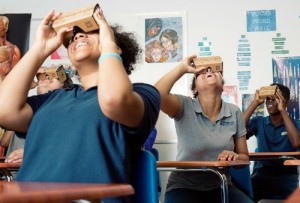2018 School Spending Survey Report
VR, Whole Libraries in a Contact Lens: ISTE 2016 Top Takeaways
Nearly 20,000 attendees convened in Denver for a notably robust ISTE 2016. From virtual reality to the new open resources platform Amazon Inspire, SLJ taps the highlights.

A disconcertingly large bear peers into the Denver convention center.
Nearly 20,000 attendees convened in Denver for a notably robust ISTE 2016. There was the unveiling of the ISTE Standards for Students and advancements on many fronts, from the integration of open resources to news from interests large (Google Education) and small (educator Kerry Gallagher’s star turn at her June 26 Ignite session, “How to Eliminate Textbooks, Paper, and Tests”). Then there’s the potential of a greater role for librarians at the national level, courtesy of Future Ready Schools. But the focal point of the annual ed-tech show, held June 26–29, was VR—or at least the promise of virtual reality to enhance education. “We’ve absolutely entered the Matrix. A really low-level version, but it is here,” said education technology expert Jason Ohler, in a June 28 presentation reflecting on key trends, reports EdTech.VR and AR
At ISTE, Google Education released its virtual trips application, Expeditions, to the public. There are now 200 expeditions to choose from, with content partners, including Houghton Mifflin Harcourt and Pearson, joining the game. For a tour, Vermont school librarian Donna Macdonald documented her Expeditions beta experience for SLJ. The app is available for Android and will be out for iPhones and iPads soon, per Google, clearly poised for fall.
Google Expeditions.
While just two percent of teachers have used VR, according to a Samsung survey, 60 percent report that they are interested in bringing the technology to the classroom. Indeed, on the ISTE show floor, crowds at the Google booth were rivaled by attendees queuing to get their hands on VR devices at Nearpod and Samsung. With its mobile learning platform being used by 3.5 million students in 10,000 classrooms every month, according to Nearpod, the San Francisco-based startup is launching the first-ever virtual reality-based curriculum. There were giveaways of Nearpod-branded Cardboard viewers, as visitors to the Samsung booth tried on Gear VR, a head-mounted device compatible with Galaxy phones. But what happens after the initial wow factor? Typically, most students spend no more than a few minutes with a 360-degree panoramic presentation, according to Mike Harper, executive vice president of zSpace, an all-in-one screen VR product. While 85 percent of teachers surveyed agree that VR would have a positive effect on education, it’s still early days. Augmented reality was represented at the show, including a #notatISTE presentation on “Augmented Interactive Student Notebooks” by educator Katie Ann Wilson. Then there’s AR Flashcards (clip below) and AR Circuits, which enables students to practice building simple electronic circuits, using physical cards in concert with an iOS app. Launched by a former teacher, AugThat creates augmented reality lessons for the school market.“Information will be everywhere and nowhere”
Physicist Michio Kaku’s vision of the future, laid out in his Sunday keynote, had implications for both teaching and librarianship. The computer, as we know it, will go away, and “information will be everywhere and nowhere,” he declared. With the entirety of the Library of Congress available at the blink of an eye outfitted with smart contact lenses, “teachers will need to stress principles and concepts rather than the drudgery of memorization,” said Kaku, to enthusiastic applause. Moreover, the inevitable drive toward online education—the shaky record on MOOCs notwithstanding—will require (human) mentors. Today, information requires curation. Enter Amazon Inspire, a free tool for the search, discovery, and distribution of digital learning content. Launched by the online retail giant at ISTE, Amazon’s new platform invites educators to upload, share, and arrange into collections free resources in line with the U.S. Department of Education’s #GoOpen initiative. Users can drag and drop files they want to share and add metadata, including a description, grade and subject, and rating, a five-star system that Amazon shoppers will recognize instantly. As expert curators, librarians would be natural users to test the Inspire platform, says Rohit Agarwal, general manager of Amazon K-12 Education. While the technology could lend itself to integration with the Amazon marketplace, easily suggesting books and other material related to user search, Inspire is strictly about non-copyrighted material, says Agarwal. Follett has opted to join #GoOpen, earlier this year pledging to integrate open education resources into its Destiny library management system by fall 2016. In addition, Follett’s purchase of wholesaler Baker and Taylor this spring will enable it “to bring superintendents and public library directors to the same table to see how they can work more closely together,” says Nader Qaimari, president of Follett School Solutions. The effort may help public librarians serve critical out-of-school learning and better use taxpayer dollars through resource sharing.Librarian power
Everywhere and nowhere might also describe the librarian presence at ISTE, as school information specialists were integrated into the fabric of the event. The ISTE Librarians Network sponsored several events in Denver, including a dynamic Librarians Playground. There, crowds pressed around tabletop sessions devoted to Book Creator, using Pinterest in the library, video game design with Bloxels, and creating fan fiction with maker tools. As the hashtag says, #cantshushthis. https://twitter.com/SherryGick/status/747737427201007616 https://twitter.com/thenerdyteacher/status/748911772736884736Launched and fêted
More news from ISTE 2016:- Smithsonian Learning Lab launches (Our coverage: "Smithsonian Learning Lab, Open for Business and Seeking Feedback")
- Google Docs now features quizzes in Google Forms
- New Chrome app Google Cast for Education allows students and teachers to share their screens wirelessly.
- The #GoOpen District Launch Packet debuts from the U.S. Office of Educational Technology
- Books That Grow wins “Most Innovative” award at the Ed Tech Start-Up Pitch Fest
- Microsoft Integration Added to Gale Products
- Two school librarians, Diana Rendina and Shannon Miller, were honored at the show.
- Common Sense Education launches a privacy evaluation tool. See how some popular ed-tech apps fare.
- Google launches Project Bloks (see below clip), a development platform for tangible programming. LEGO Education is an early partner.
RELATED
RECOMMENDED
CAREERS
The job outlook in 2030: Librarians will be in demand
CAREERS
The job outlook in 2030: Librarians will be in demand
ALREADY A SUBSCRIBER? LOG IN
We are currently offering this content for free. Sign up now to activate your personal profile, where you can save articles for future viewing






Add Comment :-
Comment Policy:
Comment should not be empty !!!
Adam
Thank you for including AR Circuits. The augmented reality circuit kit recently received a major update. New features include a voltmeter, more battery options, and redesigned parts.Posted : Jul 23, 2016 12:27